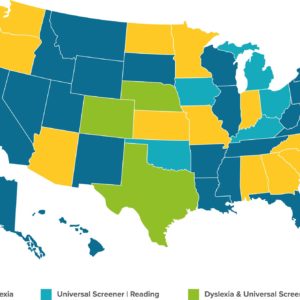What Are Norm-Referenced Assessments and Why Do We Use Them?
This time of year, with back to school quickly approaching, standardized testing is top of mind for most educators. By conducting these assessments in the fall, we have a universal standard to more fairly rank and evaluate student needs.
But what makes a standardized test a norm-referenced test? What are the goals and benefits of using norm-based assessment?
We answer these questions and more for you, including differences between norm-referenced and criterion-referenced assessments.

Table of Contents
- What Is Norm-Referenced Assessment in Education?
- 2 Goals of Norm-Referenced Assessment
- Interpreting Norm-Referenced Assessment
- How Norm-Referenced Assessment Guides Intervention
- 4 Benefits of Norm-Referenced Assessment
- What Is the Difference Between Norm-Referenced and Criterion-Referenced Assessment?
- Illuminate Education: Providing Streamlined, Data-Driven Solutions Using Norm-Referenced Assessment
What Is Norm-Referenced Assessment in Education?
Norm-referenced refers to standardized tests that assess competency using norms to interpret and report scores. Rather than using expert judgment to establish performance standards, norm-referenced tests use scores from a representative group of students from across the country. The scores from this group are converted to percentiles, usually ranging from the 1st to the 99th percentile to accurately represent the full range ability. The full-range of percentiles is divided into smaller ranges to represent performance levels or benchmarks.
2 Goals of Norm-Referenced Assessment
Two main goals of norm-referenced assessment are:
-
- To see how a student compares nationally
- To track a student’s growth over time
What is an example of norm-referenced assessment?
A norm-referenced assessment can be any standardized assessment that uses a well-defined reference group to establish performance expectations. These assessments were developed to be used nationally in programs (i.e. clinics, academic institutions, hospitals, etc.) and districts across the country. Norm-referenced assessments are also recognized by the use of normative scores such as percentiles ranks to facilitate the interpretation of student performance. Common types of norm-referenced assessments include academic screeners and interim assessments, college entrance exams, IQ tests, and many of the assessments used in the evaluation of cognitive disabilities and psychiatric disorders.
Interpreting Norm-Referenced Assessment
Norm-referenced assessment tells you how a specific student performed on the test compared to the performance of the norm group.
One way to consider how to interpret a norm-referenced assessment is to think about a baby’s growth comparison at a doctor’s office. At each well-baby visit, the baby’s weight and length are compared to the results obtained in the population of infants of the same age from across the country.
#1: Universal Screening
The key goal of norm-referenced assessment is to identify how a student performs compared to others in a predetermined peer group. This helps indicate the level of risk, or need, of the student.
Universal screening assessments are norm-based assessments of students with the intent of identifying students who may be at risk for poor learning outcomes.
This assessment is typically:
-
- Brief
- Reliable; and
- Valid
Students from across the country (who are typically in the same grade level) take an assessment. Administrators can then analyze their scores to learn about their compared performance.
Consider these two norm-referenced assessment examples:
-
- If a student’s test score corresponds to the 75th national percentile, you know this student is performing at or above 75 percent of students in the national population, which is above the national average for his current grade and season on that particular test.
- If another student’s score on the same test shows the 35th national percentile, you know this student is performing just below the national average for her grade level.
This information is important, so you know how much extra help a student needs to be considered “on-track,” for success by the end of the year.
FastBridge: Illuminate Education’s Solution for Universal Screening Tools
FastBridge is a norm-referenced universal screening assessment solution that offers both curriculum-based measures (CBM) and computer adaptive tests (CAT).
FastBridge tests in:
-
-
- Reading
- Math; and
- Social-emotional behavioral
-
This combined approach improves reliability and validity of decisions by giving educators more accurate data about student learning — with results back faster than any other system.
#2: Progress Monitoring
Another important goal of norm-referenced assessment is to regularly monitor a student’s progress in a particular area — typically weekly or biweekly.
Progress monitoring tools are used to provide information about students who are participating in targeted Tier 2 and Tier 3 interventions.
Progress Monitoring has three main objectives:
-
- To evaluate student learning outcomes:
- Tracking a student over time will show if a student has made expected gains with the provided intervention, as well as the additional gains needed to catch up to peers.
- To consider instructional change:
- Progress monitoring helps teachers evaluate their own practices. A teacher can revise an intervention when progress data shows a student is not making gains.
- To determine eligibility for other educational services:
- Monitoring helps to determine if a student needs services and which services they may need, including special education services.
- To evaluate student learning outcomes:
FastBridge: Illuminate Education’s Solution for Progress Monitoring Tools
With FastBridge’s innovative progress monitoring tools, educators not only can measure students’ rates of improvement, but …., but they can determine whether the student is on-track to meet the goal six weeks earlier than with traditional methods…
Teachers use this information to determine if instruction and interventions should be …
-
-
- Maintained
- Modified; or
- Intensified
-
… to close gaps with just six data points.
This is possible due to our patent-pending algorithm, FAST Projection™ line that delivers actionable insight in just six to twelve weeks — allowing educators to quickly get students back on track.
How Norm-Referenced Assessment Guides Intervention
A norm-referenced assessment used in universal screening is designed to help you identify which students need extra support, which are on-track, and which students might benefit from accelerated instruction. Because they are brief, they do not always tell you what support needs to get back on track but by combining different assessment data educators can create a fuller picture of which skills may need to be taught in order for students to gain proficiency.
By using assessment data, educators can determine if an intervention needs to occur:
- At the class-level during whole group instruction (“Tier 1”)
- In a small group setting where all students (“Tier 2”); or
- Individual student interventions (“Tier 3”)

4 Benefits of Norm-Referenced Assessment
There are four key advantages of using norm-referenced assessments:
- Norm-referenced assessments are developed by content and assessment experts, piloted, and revised before they are used by students.
- Norm-referenced assessments are dependable and stable for what they are designed to measure.
- Norm-referenced assessments can help differentiate students and identify those who may have specific educational needs or deficits that require specialized assistance or learning environments.
- Norm-referenced assessments are an objective evaluation method that can decrease bias or favoritism when making educational decisions.
What Is the Difference Between Norm-Referenced and Criterion-Referenced Assessment?
Both norm-referenced and criterion-referenced refer to how scores are interpreted, not the type of assessment.
The main difference is norm-referenced refers to how a student’s score compares to other students, while criterion-referenced refers to how a student’s score compares to a criterion, such as a predetermined standard or goal.
Interpreting Criterion-Referenced Assessment
A criterion-referenced assessment, or score, compares a student’s knowledge or skills against a criterion. The criterion might be based on expert judgment of, say proficiency, or it might be based on an external indicator like the performance on another well-established test. In other words, the performance categories are not determined strictly by performance of other students.
State accountability assessments are typically considered criterion-referenced assessments because they report results as proficiency levels which were established through carefully designed protocols using expert teacher judgment about what student ought to know and be able to do at the end of the grade.
Usually, the criterion is a single score or a few scores that result in 2 to several performance categories. Therefore, criterion-referenced results tell you whether or not a student met a standard but not how far above or below the standard the student performed. They also do not communicate the relative standing of a student in the population – how a student’s specific score compares to their peers.
Academic tests often use “cut scores” to place students into categories, such as:
-
- Basic
- Proficient; and
- Advanced
Benefits of Criterion-Referenced Interpretation
Criterion-referenced interpretation is well-suited in contexts where there is consensus about the standard. Because standards are established from expert judgment or other well-established criteria, they are seen as more objective. Also, criterion-referenced categories are generally very stable across time which facilitates planning and implementation.
Can a test provide norm-referenced and criterion-referenced interpretations?
The short answer is “yes.” There are many instances of assessments that couple norms with criterion-referenced performance categories.
As an example, many universal screeners report both types of scores. Risk categories are often derived from empirical studies that use screener scores to predict a well-established outcome such as the “proficient” classification on a state test. Statistical models are used to identify the screener score that optimizes classification accuracy. Universal screeners also report national percentile scores. The combination of information makes them more suitable for a variety of uses included determining who needs additional instructional support and program evaluation.
Illuminate Education: Providing Streamlined, Data-Driven Solutions Using Norm-Referenced Assessment
The right universal screening tool should provide key information to all affected departments and teams.
Illuminate Education’s norm-referenced assessment solutions can help your district save …
- Money
- Testing time; and
- Professional development hours
… while consolidating systems and reporting.
Reach out to schedule a demo and to learn more.



